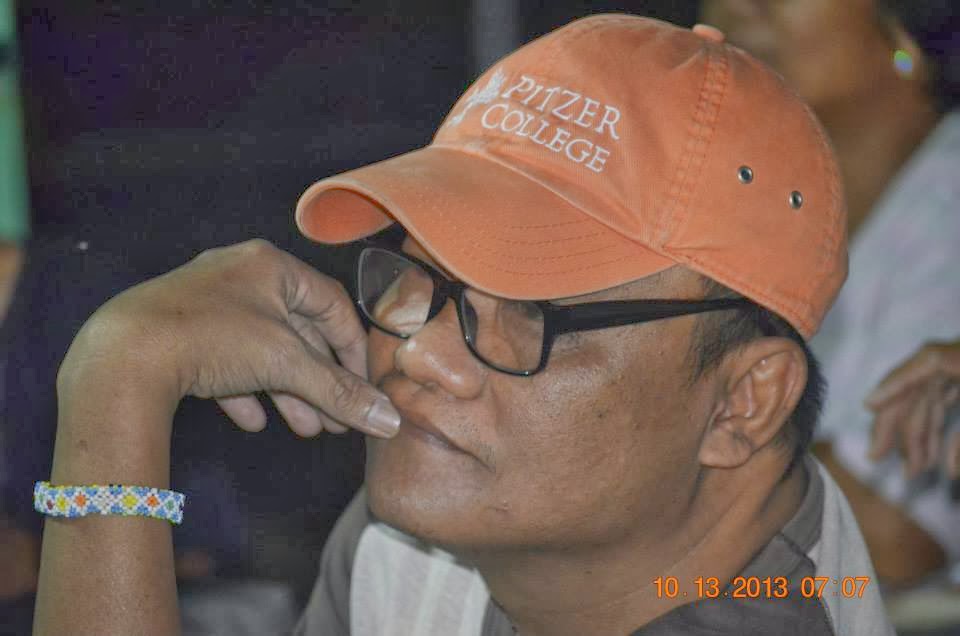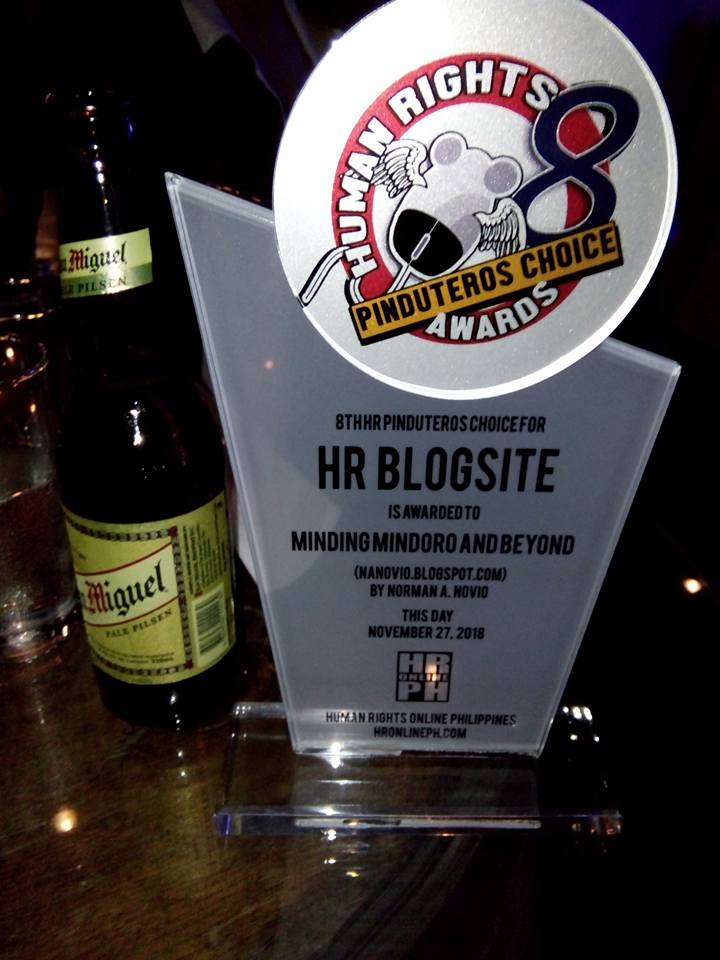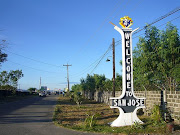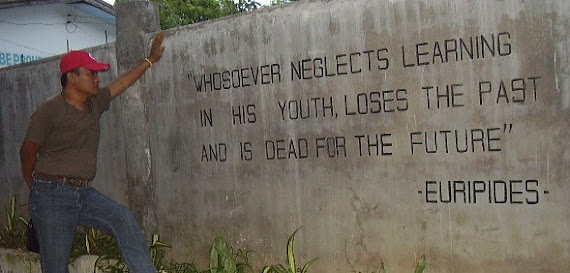Ang
Abril ay Buwan ng Panitikang Filipino.
Simulan
natin ito sa isang pandaigdigang pangungutya na palasak pa hanggang ngayon. Ang
mga aklat o sulating pangkasaysayan daw ay pampasikip lang sa mga silid-aklatan
(“so much dead weight on library shelves”)
at ang mga aklat na ito ay “the
dullest of all the dullest book.” Bakit kaya walang gaanong tumatangkilik
sa mga ito? Ano ang kaugnayan ng panitikan sa kasaysayan?
Ang
Kanlurang Mindoro ay hindi magagawang makutya ng mga ganitong pananaw. Una, bihi-bihira
ang nagsusulat ng lokal na kasaysayan sa atin. Ikalawa, wala naman tayong mga
pampublikong silid-aklatan na pasisikipin ng mga ganitong sulatin o aklat.
Bakit kaya? (At maraming pang “Bakit” ang kasaysayan ng ating lalawigan!)
Pero
ang kutyang ito ay hamon sa atin na sumunod sa mga yapak ng mga sinauna nating
historyador kagaya nina Rudy A. Candelario at ng mga yumaong sina Propesor
Remegio A. Agpalo, Gil C. Manuel at Rodolfo Meim-Acebes. Isang pagpupugay sa
kanila at sa kanilang legasiya.
Ipinapalagay
ng marami na ang kasaysayan ay walang praktikal na gamit hindi kagaya ng
matematika. Nakakauta pa raw magsa-ulo ng mga pangalan, lugar, petsa at
kaganapan na parang wala namang magiging direktang kaugnayan sa ating
pang-araw-araw na buhay. Kunsabagay…
Sabi
ni Tip O’Neill, dating kasapi ng Mababang Kapulungan ng Estados Unidos, “All politics is local”. (“Ang lahat ng
pulitika ay lokal”) at gayundin ka-totoo na ANG LAHAT NG KASAYSAYAN AY LOKAL. Upang mas lumawak ang kaalaman ng
mga Filipino sa pambansang kasaysayan, kinakailangang paigtingin ang
pananaliksik at pagsusulat sa mga lokal na kasaysayan.
“Hindi mabubuo ang
pambansang kasaysayan kung hindi maganda ang lokal na kasaysayan,” wika ni Xiao Chua, isang
kilalang propesor ng kasaysayan. Ano ang ambag ng mga manunulat ng Kanlurang
Mindoro sa usaping ito?
Para
sa mga nasa akademiya, sa mga kolehiyo at pamantasan, kailangang mahusay na
maituturo ang pambansang kasaysayan sa tulong ng mga nakalap na kasaysayang
pam-pook. Dapat na maging mausisa ang mga guro sa kasaysayan ng mga lugar na
kanilang ginagalawan.
Ang
mga kuwento ng mga henerasyong nauna sa atin o yaong mga naunang namuhay sa
Isla ng Mindoro ay kailangang makalap, masulat at maalagaan bago ito tuluyang
mawala sa mga susunod pang henerasyon. Lalo na ang mga Mangyan. Lalo na ang mga
mahihirap na parang hindi kinukonsidera na mga pangunahing aktor ng kasaysayan.
Sabi
nga ni Virgilio S. Almario, kahit ang Balagtasan ay naglalayon para sa mas
mataas na panlipunan at pampulitikang mga tungkulin. Lampas sa paghahatid ng
saya, pinapataas nito ang tradisyunal na papel ng makata bilang tagapag-hatid
ng katotohanan sa sambayanan.
Ating
balikan, kung ang lahat ng pulitika ay
lokal, gayundin ang lahat ng kasaysayan. Tumpak lang na maipalagay, na ang
mga Pamahalaang Lokal ay malaki ang maiaambag sa layuning ito. Una, dapat na
ang mga opisyal ng pamahalaan ay may pandama sa panitikan, kasaysayan at
kultura. Papaano?
Pangarap
natin na magkaroon ng isang Sentrong Pangkamalayan sa Kasaysayan at Kultura sa
Kanlurang Mindoro. Ito ang magpapatatag sa samahan ng mga propesyunal,
historyador, guro, at mga mag-aaral na nasa larangan ng kasaysayang pam-pook at
mga pamana o legasiya.
Pagpu-pondo
sa mga gawaing pananaliksik at dokumentasyon hanggang sa paglilimbag. At pag-aaral
at pagsasa-praktika ng mga makabagong metodo ng pananaliksik.
Pagsasagawa
ng mga manuskrito ukol sa ating mga natatanging ka-lalawigan kabilang ang mga
lokal na bayani na magtatampok sa kanilang talambuhay at mga gintong kaisipan at
dakilang adhikain. Ilan lamang ito sa maraming bagay na maaring gawin ng mga
lokal na pamahalaan, lalong lalo na ang pamahalaang panlalawigan para sa
kasaysayang pam-pook.
ANG KASAYSAYANG PAM-POOK
AY MAKATUTULONG UPANG UNAWAIN SA TAMANG KONTEKSTO ANG ATING MGA NINUNO O SINAUNANG
MAMAMAYAN. Dito
pumapasok ang aking pahilis o pagkiling sa mga Mangyan. (Hindi po ninyo
naitatanong, ako ay ang kasalukuyang Indigenous
Peoples’ Affairs Officer (IPAO) ng Bayan ng Sablayan).
Ang
papel ng Mangyan sa kasaysayang pam-pook ay dapat na masalamin at
mabigyang-tampok. Ito ay upang malaman din ang kanilang kasalukuyang
kalalagayan at mga suliranin upang matugunan ng mga kinauukulan batay sa epekto
ng mga ito sa kanila.
ANG MGA KASAYSAYANG
PAM-POOK AY MAKATUTULONG SA ATING PAG-UGIT KUNG SINO TAYO. Nasa mundo tayo ngayon
ng estereotipo. Ang estereotipo ay ang pagtukoy o pagbanggit sa lahat ng negatibong
bagay kahit hindi naman totoo. Ang direktang kahulugan nito sa wikang Filipino
ay ang pamamaraan ng pambubuska o mabilisang paghusga ng isang tao sa isa pang
uri o grupo ng mga tao.
Halimbawa
na lamang, ang mga Mangyan ay hindi marunong mag-isip, mga tanga at mga bobo.
Ang mga pinuno ng pamahalaan ay matatalino at may mas malaking maiaambag sa
kaunlaran ng bayan kaysa sa mga Mangyan. Ang mga kababaihan ay “pambahay” lang
at “pang-kama”, at marami pang iba. Magbigay ng halimbawa.
Sabi
ni Victoria Plaut isang panlipunan at kultural na sikolohista sa Unibersidad ng
California sa kanyang artikulong, “The
Cultural Construction of Self and Well-Being: A Tale of Two Cities,”
mayroon umanong mga ebidensya na tumutukoy na ang ating mga pook na sinilangan,
tinitirhan o pinanggalingan ay may malaking kontribusyon at papel kung sino
tayo at kung ano ang pananaw natin sa mundo.
Sa
kanyang pananaliksik, malinaw umano na sa kambal nating mga pagkakaiba sa
personalidad, ang kultural na pag-inog sa partikular na konteksto ng isang tao
ay susing daluyan ng kanyang sarili at pagkatao.
Dagdag
pa ni Plaut sa kanyang sulatin na isinalin ko rin, “Sa huli, pagdating sa
pananaw sa kanyang sarili ng isang mamamayan ng isang pook at kanyang ganap na
kagalingan, may malaking kinalaman ito sa lokal na kultura at kasaysayan” (na
maaring nasusulat o hindi).
Ngayon,
papaano mo sasabihin na walang praktikal na gamit ang kasaysayan kung katulad
ng Pilosopiya ay naglalayon itong tuklasin kung ano ang tao, sino tayo at ano
ang layon natin sa daigdig? Kung may kagnayan ito sa pananaw natin sa ating
sarili, saang lupalop natin kinuha ang pananaw na wala itong praktikal na gamit
o kaugnayan sa buhay natin?
Ang
totoong gampanin ng isang historyador o guro ng panitikang pang-kasaysayan ay
ang pagpapaliwanag na may kaugnayan at paralelismo ang kasaysayan at ang ating
personal, espiritwal at panlipunang pag-iral.
(Akin-akin
lang po yan.)
Tungkulin
ng mga grupong pampanitikan at pang-kasaysayan na gumamit ng panlipunang
kritisismo bilang isang pangkasaysayan metodo. Ito lamang ang ating sandata sa
delusyon ng paggamit sa mga pansariling layon at adyenda ng mga elitista. Ito
dapat ang ating kiling sa ating pag-iral (“existential bias” ang tawag ko dito).
Hamon
sa ating mga historyador ang palaguin ang ating sarili sa ganitong kaisipan at
layon na maaring nating tawaging “mental faculty”.
(Lalong
akin-akin lang po ito.)
ANG KASAYSAYAN AT
PANITIKAN AY MAGKA-UGNAY. Ang panitikan at kasaysayan ay magkaugnay sapagkat ang ating
mga ninuno at maging yaong mga nabubuhay sa panahon natin ngayon ay gumagamit
ng panitikan sa pagdodokumento at patatala ng mga pangyayari. Ang mga talang
ito ay sumasalamin sa mga pangyayaring panlipunan sa bawat yugto ng panahon.
Samakatuwid, ang panitikan ay nagsisilbing batayan ng kasaysayan dahil tumutukoy
ito sa ating buhay pamayanan. Ang kasaysayan din ay kasalukuyang mga pangyayari
na isinusulat sa panitik ng kasalukuyan.
Ang
pagsusulat ng kasaysayan at panitikan ay dapat na kritikal sa mga nangyayaring
masama sa paligid sapagkat kung babasahin din natin ang kasaysayan, ang
panitikan ay dapat na mapagpalaya at nagbabadya at nagtataguyod ng karapatang
pantao.
Layunin
ng historyador at manunulat na magpamulat kung papaano ang katotohanan ay
siyang magpapalaya sa ating lahat.
PAGLALAGOM. Ang aking pagba-blog ng
kasaysayang pam-pook ay libangan lang. Ako ay isa lamang sa sinasabi ni Sass Rogando
Sasot na “minimal blogger”. Hindi para sa akademiya ang aking mga
isinulat at isusulat pa. Hindi ko rin layon na maisa-aklat ang mga ito. (Pero
kung may magka-interes, bakit hindi?)
Dalawang
tao ang naka-impluwensya sa aking mag-blog. Si Philip Alcantara, dati kong
direktor sa panlipunang apostolado ng Bikaryato Apostoliko ng San Jose at si
Joma V. Cordova, bayaw ko sa pinsan. Una akong nagsulat sa Filipino pero
sinanay ko na ring gumamit ng wikang Englis. Sa wikang ito ako nagsimulang
mag-blog. Ngayon, ang lahat ng mga natatanggap kong pasasalamat sa mga taong
naka-istorya ko ang nagbibigay-sigla sa aking magpatuloy.
Mas
lalong hindi ko itinuturing na ako ay isang historyador dahil wala naman akong
kasanayang pormal dito. Simple lang ang dahilan kung bakit ako nag-ba-blog ng kasaysayang pam-pook,
makakalimutin ako. Masaya akong maka-alala at magpa-ala ng mga naganap at mga
nagaganap para sa aking sarili at para sa aking mga kaibigan at mga mambabasa.
At
sa aking pagsusulat hindi sinasadyang, sabi nga ni Dr. Arnulfo T. Villanueva na
siyang direktor ng Sentro ng Wika at Kultura- Kanlurang Mindoro, sa kanyang
liham paanyaya sa akin, ako ay makapag-ambag sa aking munting paraan sa
pagpipreserba ng literatura at kasaysayan sa ating lalawigan. Salamat din sa aking dating guro sa Filipino na si Gng. Resyjane P. Tabangcura sa pagtitiwala sa aking kakayahan.
Itinuturing
ko ang aking sarili bilang isa lamang obhetibong tsismoso at makabagong Lola
Basyang o simpleng kwentista ng bayan sa net. Aksidente lang na may malawak na naabot
ang aking mga panulat.
Salamat
sa Diyos sa aksidenteng ito.
Sa
pagtatapos. Ang mga may sariling adyenda sa pulitika at negosyo ay maaring
gamitin ang mga alagad ng panitikan at kasaysayan. Sa kanila, tayo ay pawang
mga taga-sulat lamang, taga-tago at taga-salansan ng mga sulatin o rekord ng
mga tao at pangyayari sa ating lokalidad.
Gagamitin
nila tayo sa kanilang interes.
PERO
BIBIGUIN NATIN SILA!
(Akin-akin
lang po ito ulit.)
Maraming
salamat po sa inyong pagtitiwala at mabuhay tayong lahat!
-------
(* Pagbabahagi ng may-akda sa Mina at
Minanang Panitikan ng Mindoro: Isang Tertulyang Pampanitikan noong ika- 26 ng
Abril, 2018 sa Sikatuna Beach Hotel, San Roque II, San Jose, Occidental Mindoro.
Larawang kuha ni Gng. Lhorie Moises)








